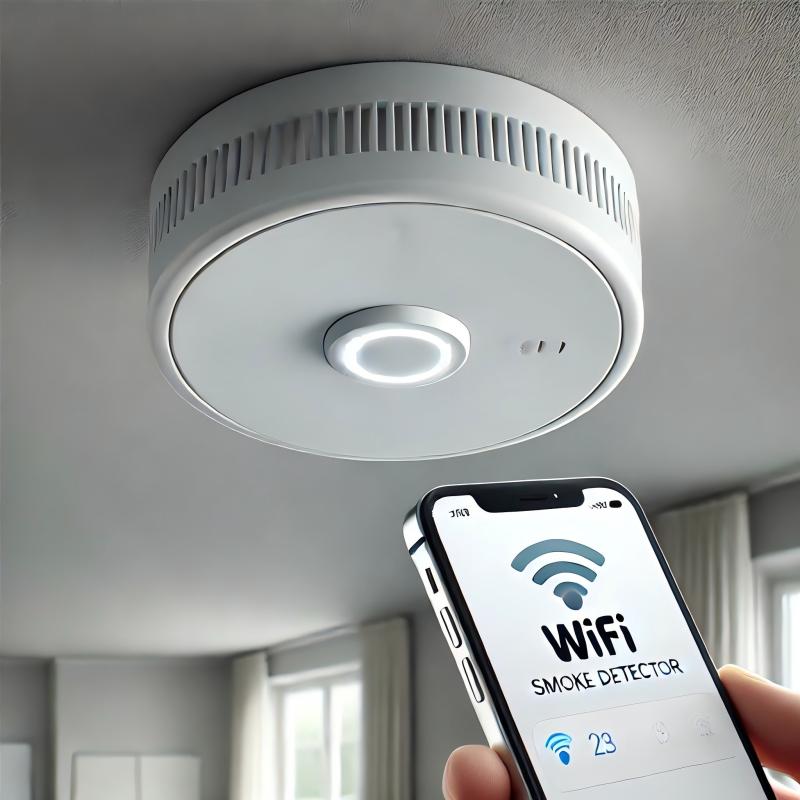With the rapid development of smart home and IoT technologies, networked smoke detectors have quickly gained popularity worldwide, emerging as an important innovation in fire safety. Unlike traditional standalone smoke detectors, networked smoke detectors connect multiple devices through wireless networks, enabling rapid alerts across an entire building in case of a fire, enhancing safety significantly.
1. How Networked Smoke Detectors Work
Networked smoke detectors utilize wireless communication technologies like Wi-Fi, Zigbee, and NB-IoT to connect multiple devices into a secure network. When one detector senses smoke, all linked detectors simultaneously sound an alarm. This synchronized alert system greatly increases response time, giving residents crucial extra moments to evacuate.
For example, in a multi-story residence, if a fire breaks out in the kitchen, networked smoke detectors ensure that everyone in the building receives an alarm, reducing the danger from spreading flames. This wide-reaching alarm system is particularly essential when family members are dispersed throughout the home, such as at night or when children and elderly family members are in separate rooms.
2. Key Advantages of Networked Smoke Detectors
Networked smoke detectors are increasingly used in both residential and commercial settings due to several key benefits:
- Whole-Home Coverage: Unlike standalone alarms, networked smoke detectors provide whole-home coverage, delivering alerts to every corner, thereby fully protecting all residents.
- Quick Response: With multiple detectors responding simultaneously, alarm delays are minimized, allowing for quicker evacuation, which is especially valuable in large homes or multi-story buildings.
- Smart Management: Through a mobile app or smart home system, users can remotely monitor and manage networked smoke detectors, checking device status, receiving alerts, and quickly handling false alarms.
- Scalability: As home systems expand, networked smoke detectors allow for easy addition of new devices without rewiring or complex setups, enabling users to build out their safety network as needed.
3. Typical Applications of Networked Smoke Detectors
The multifunctionality and expandability of networked smoke detectors make them suitable for various scenarios. Here are some typical application areas:
- Home Safety: In the European and North American markets, more families are installing networked smoke detectors, especially in multi-story houses or villas. Networked alarms enable family members to respond swiftly to fire hazards, avoiding potential fire risks.
- Hotels and Apartments: In hotels and rental apartments where occupants are densely packed, fires can cause extensive property damage and loss of life. Networked smoke detectors can trigger alarms throughout the building during the early stages of a fire, providing greater safety for occupants.
- Commercial Buildings: Networked smoke detectors are also valuable in office buildings and commercial facilities. The inter-floor alarm function ensures people can evacuate quickly, minimizing potential damage.
4. Market Outlook and Challenges
According to market research agencies, demand for networked smoke detectors is growing rapidly, particularly in markets with stringent safety standards like Europe and North America. This trend is driven not only by technological advances but also by increasing consumer awareness of safety. Some governments are now including networked smoke detectors as part of standard fire safety installations to improve overall fire protection.
Despite their advantages, networked smoke detectors face some challenges in widespread adoption. For instance, the initial installation costs can be relatively high, particularly for large or multi-level buildings. Additionally, compatibility issues among different brands can affect integration with smart home systems. As a result, manufacturers and technology providers of networked smoke detectors need to invest in standardization and interoperability to deliver a more seamless user experience.
5. Future Developments
In the future, with the widespread adoption of IoT and 5G technology, the performance and applications of networked smoke detectors will expand further. Next-generation detectors may incorporate AI recognition features to differentiate between fire types or reduce false alarms. Additionally, more devices will support voice control and cloud storage, enhancing the smart user experience.
In conclusion, networked smoke detectors represent a major advancement in fire safety. They are more than just alarm devices; they are comprehensive safety systems. Through rapid market adoption and technological innovation, networked smoke detectors are set to provide reliable fire protection for more homes and commercial spaces, bringing greater peace of mind to people’s lives.
Post time: Nov-01-2024




